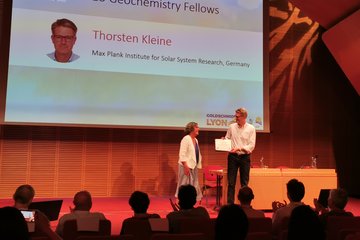Alle Typen
1.
Zeitschriftenartikel
Possible evidence of Alfven-cyclotron waves in the angle distribution of magnetic helicity of solar wind turbulence. Astrophysical Journal 731, 85 (2011)
2.
Zeitschriftenartikel
Two-dimensional correlation functions for density and magnetic field fluctuations in magnetosheath turbulence measured by the Cluster spacecraft. Journal Geophysical Research 116, A06207 (2011)
3.
Zeitschriftenartikel
Quasi-periodic outflows observed by the X-Ray Telescope onboard Hinode in the boundary of an active region. Res. Astron. Astrophys. 10 (12), S. 1307 - 1314 (2010)
4.
Zeitschriftenartikel
Magnetic and spectroscopic properties of supergranular-scale coronal jets and erupting loops in a polar coronal hole. Astronomy and Astrophysics 519, A49 (2010)
5.
Zeitschriftenartikel
Intermittent outflows at the edge of an active region - a possible source of the solar wind? Astronomy and Astrophysics 516, A14 (2010)
6.
Zeitschriftenartikel
Solar wind origins in coronal holes and in the quiet Sun. Advances in Space Research 45, S. 303 - 309 (2010)
7.
Zeitschriftenartikel
New views on the emission and structure of the solar transition region. New Astron. Rev. 54, S. 13 - 30 (2010)
8.
Zeitschriftenartikel
Horizontal supergranule-scale motions inferred from TRACE ultraviolet observations of the chromosphere. Astronomy and Astrophysics 519, A58 (2010)
9.
Zeitschriftenartikel
The nascent fast solar wind observed by the EUV imaging spectrometer on board Hinode. Astrophysical Journal 709, S. L88 - L93 (2010)
10.
Zeitschriftenartikel
Signatures of magnetic reconnection at boundaries of interplanetary small-scale magnetic flux ropes. Astrophysical Journal 720 (1), S. 454 - 464 (2010)
11.
Zeitschriftenartikel
Excitation of kink waves due to small-scale magnetic reconnection in the chromosphere? Astrophysical Journal 705, S. L217 - L222 (2009)
12.
Zeitschriftenartikel
Upflows in funnel-like legs of coronal magnetic loops. Astrophysical Journal 704, S. 883 - 890 (2009)
13.
Konferenzbeitrag
Upward and downward propagation of transverse waves due to small-scale magnetic reconnection in the chromosphere. In: Twelfth International Solar Wind Conference, S. 32 - 35 (Hg. Maksimovic, M.; Issautier, K.; Meyer-Vernet, N.; Moncuquet, M.; Pantellini, F.). American Institute of Physics (2010)
14.
Konferenzbeitrag
Upflows in the upper transition region of the quiet Sun. In: Twelfth International Solar Wind Conference, S. 36 - 39 (Hg. Maksimovic, M.; Issautier, K.; Meyer-Vernet, N.; Moncuquet, M.; Pantellini, F.). American Institute of Physics (2010)











